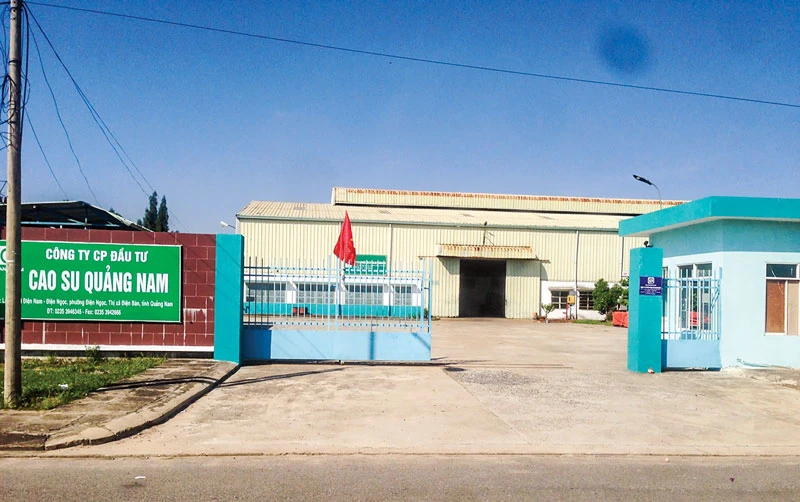
Golden age of VHG
The precursor for VHG is Viet Han Investment and Production Joint Stock Company that was established in 2003, with an initial charter capital of VND 6 bn. In the early years, VHG mainly produced telecommunication cables in the form of OEM for its Korean partners. In 2005, VHG officially exported the first batch of telecommunication cables. In 2006, VHG became the largest cable manufacturer in Vietnam after launching a 2,400-pair telecommunications cable market. In 2007, VHG put into operation the largest telecommunication cable factory in Vietnam with a capacity of 3 million km per year.
It can be said that this was the golden age of VHG with a series of large scale investment projects such as FRP fiberglass factory, VMC material factory, completing the Phase 2 project for VPC and VPF factory, implementing a 4.115 ha. rubber plantation project in Quang Nam, successfully producing FRP with a diameter of over 4m, acquiring Viet Han Plastic JSC, and owning two buildings in Danang. With such rapid development, VHG was listed among the Top 500 largest private enterprises in Vietnam and its shares were held by domestic and foreign investment funds such as Indochina Capital and Vina Capital.
The peak for VHG was its listing on HOSE in early 2008 with a reference price of VND 96,000 per share. However, VHG could not keep up at this price level when the overall market was in a strong correction phase after the boom in 2007. This correction, combined with a slowdown in profits, dragged VHG closer to a reference price of VND 10,000 per share in 2009.
Failed to change axis
Impatient after the decline in stock prices, the Board of Directors at VHG decided to change the development strategy with the expectation of bringing the share price back to its earlier value. As a result, the Board of Directors decided to build VHG around the axis of other businesses such as real estate, industry infrastructure and services, rubber plantation and processing, production of basic construction materials, and investing and processing of non-ferrous metals. However, this effort to revive VHG backfired and pushed VHG into a loss making business in coming years. Specifically, in 2011 the loss was at VND 36.15 bn, and by 2012 the loss had increased to VND 66.13 bn.
In 2013, VHG continued to restructure again with a new development-oriented strategy of taking the rubber sector as its main business. In keeping with this strategy, VHG changed its business name from Viet Han Investment and Production Joint Stock Company to Quang Nam Rubber Investment Joint Stock Company, and increased its charter capital from VND 375 bn to over VND 750 bn. This additional capital was poured into the VHG project of planting and exploiting 13,300 ha. of rubber plants in Quang Nam, and the Non Nuoc beach resort project in Da Nang, over an area of about 5.3 ha. In particular, the Board of Directors put a part of this capital into securities. In fact, almost every year that VHG raised the issue of restructuring at the General Meeting of Shareholders, the following subsequent year saw more losses than the previous year.
Speculative stock
This unfortunate turn in business gave VHG the title of "speculative stock" on HOSE. For example, at the 2013 Annual General Meeting of Shareholders, VHG shareholders approved the restructuring of the entire company, and transfer of assets and shares from subsidiaries or associates. It is worth mentioning that at the 2013 shareholders meeting, VHG again announced a loss of VND 20 bn and was willing to delist because of three consecutive years of losses. However, at the Extraordinary General Meeting of Shareholders, VHG made drastic changes on its Board. The new Board of VHG adjusted the business plan to convert losses into profits by VND 130 bn, a 10% dividend in cash and a bonus share dividend of 2:1. Although not meeting the plan, the profit in 2013 was no longer negative, saving VHG from risk of delisting due to losses for three consecutive years.
This unexpected information was one of the reasons for the unpredictable fluctuation in the price of VHG. In this period, VHG had up and down sessions and pushed up very strongly. According to statistics, VHG had increased waves from VND 3,000 per share to VND 15,000 per share, but also dropped from VND 12,000 per share to only VND 6,000 per share. This is the factor that made VHG the favorite stock code for surfing investors with millions of shares traded at each session. Even many internal shareholders of VHG participated in this surfing to make profit.
The focus on stock price is also the reason why VHG business situation cannot recover, with the post-tax profit of the parent shareholders in 2018 being negative at VND 320 bn, bringing the accumulated losses upto VND 1,256 bn. With this result, VHG was delisted on HOSE due to losses for three consecutive years from 2016-2018. Specifically, in 2016, it lost VND 32.5 bn, and in 2017 it lost VND 1,178 bn. By the end of 2018, the VHG short-term assets were at VND 66.7 bn, while liabilities were at VND 175 bn, of which short-term debts were at VND 45.8 bn.
On 31 May 2019, 150 million VHG shares were listed on UPCoM again with reference price of VND 1,300 per share. However, this return of VHG took place quietly when investors were no longer interested. Faced with indifference of investors, VHG not only lost liquidity but also plummeted down to VND 500 per share.




















